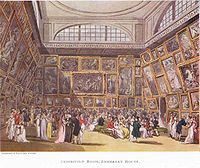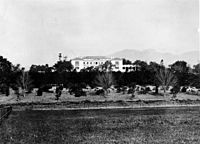- Pinkie (Lawrence painting)
-
 Sarah Barrett Moulton: “Pinkie” by Thomas Lawrence. Oil on canvas, 57½" x 39¼" (146 x 100 cm).
Sarah Barrett Moulton: “Pinkie” by Thomas Lawrence. Oil on canvas, 57½" x 39¼" (146 x 100 cm).
Pinkie is the traditional title for a portrait of 1794 by Thomas Lawrence in the permanent collection of The Huntington at San Marino, California where it hangs opposite The Blue Boy by Thomas Gainsborough. These two works are the centerpieces of the institute's art collection, which specializes in 18th-century English portraiture. The painting is an elegant depiction of Sarah Barrett Moulton, who was about eleven years old when painted. Her direct gaze and the loose, highly-movemented brushwork give the portrait a lively immediacy.[1][2][3]
Contents
Origin
Sarah Goodin Barrett Moulton was born in 1783 in Jamaica.[2][4] She was the daughter of Charles Barrett Moulton, a wealthy plantation owner. Lawrence's portrait was a commission by her grandmother at the time Sarah left Jamaica with her brothers to complete her education in England. The portrait's title and obvious visual puns refer to Sarah's family nickname, "Pinkie". She died on April 23, 1795, one year after the portrait was completed, probably of whooping cough, contracted from one of her brothers[5].
 The 1800 Royal Academy exhibition at Somerset House
The 1800 Royal Academy exhibition at Somerset House
Pinkie was probably first displayed at the 1795 Royal Academy summer exhibition.[6] According to an official Huntington Library publication:
"Many of the finest works by the most gifted English artists of the period were large formal portraits. Although most of the pictures were commissioned by the sitter, many were also intended for public display. They made their first appearances at the annual Royal Academy exhibition, which was then the principal artistic event of the year. A somewhat grand and rhetorical air was considered appropriate for this type of painting, and this artistic intention should be kept in mind when looking at the portraits in the Huntington collection."[7]Sarah's brother Edward, who later owned the portrait, changed his surname to Moulton-Barrett. He became the father of poet Elizabeth Barrett Browning.[2][4] The painting was one of the last acquisitions of California land developer Henry E. Huntington in 1927.[2][8] In 1934 the Huntington foundation constructed a new main gallery as an addition to the former residence for the collection's major portraits. Except for brief intervals during traveling exhibitions, Pinkie has hung there since that time.[9]
Relationship to The Blue Boy
Pinkie owes part of its notability to its association with the Gainsborough portrait The Blue Boy. According to Patricia Failing, author of Best-Loved Art from American Museums, “no other work by a British artist enjoys the fame of The Blue Boy.”[10] Pinkie and The Blue Boy are often paired in popular esteem; some gallery visitors mistake them for contemporary works by the same artist.[11][12] Actually the two were created by different painters a quarter century apart, and the subjects' dress styles are separated by over one hundred fifty years. Jonathan Buttall, who posed for Gainsborough's portrait, wears a period costume of the early 17th century as an homage to Flemish Baroque painter Anthony Van Dyck, whom Gainsborough held in particular esteem. Sarah Moulton wears the contemporary fashion of 1794.[9][10] The two works had no association until Henry Huntington purchased them in the 1920s.[11]
Nonetheless, the two are so well matched that William Wilson, author of The Los Angeles Times Book of California Museums, calls them "the Romeo and Juliet of Rococo portraiture" and notes that their association borders on cliché:
"They have decorated cocktail coasters, appeared in advertisements, and stopped the show as the tableaux vivants at the Laguna Beach ‘Pageant of the Masters.’ For all that, they remain intrinsically lovely… "The continuing popularity of both pictures is based on more than the obvious. The subjects certainly are in the springtime of life, but their freshness is lent a certain poignancy by the rather grown-up garb that suggests both the transience of youth and the attempt to cling to it. Besides, both are extraordinarily fine pictures, easy and dramatic at once."[12]See also
Citations
References
- Bernal, Peggy Park (1992). The Huntington: Library, Art Collections, Botanical Gardens. San Marino, California: The Huntington Library.
- Failing, Patricia (1983). Best-Loved Art from American Museums. New York: Clarkson N. Potter, Inc.
- Pomeroy, Elizabeth (1983). The Huntington: Library, Art Gallery, Botanical Gardens. London: Scala/Philip Wilson.
- Ritchie, Ward (1986). The Huntington Art Collections: A Handbook. San Marino, California: The Huntington Library.
- Wilson, William (1984). The Los Angeles Times Book of California Museums. New York: Harry, Abrams, Inc.
- Secrest, Meryle (2004). Duveen: a life in art. New York, Random House, Inc.
External links
Categories:- 1794 paintings
- 18th-century portraits
- English paintings
Wikimedia Foundation. 2010.


